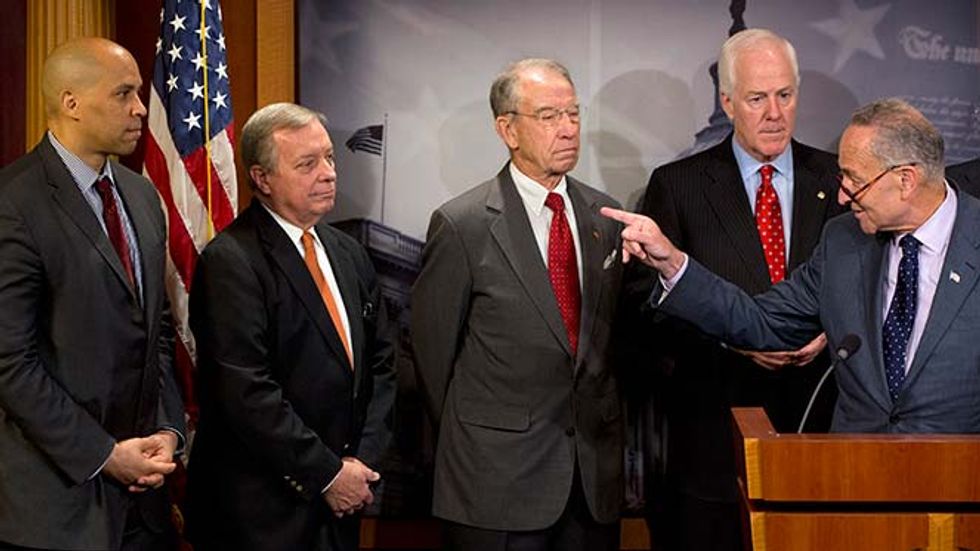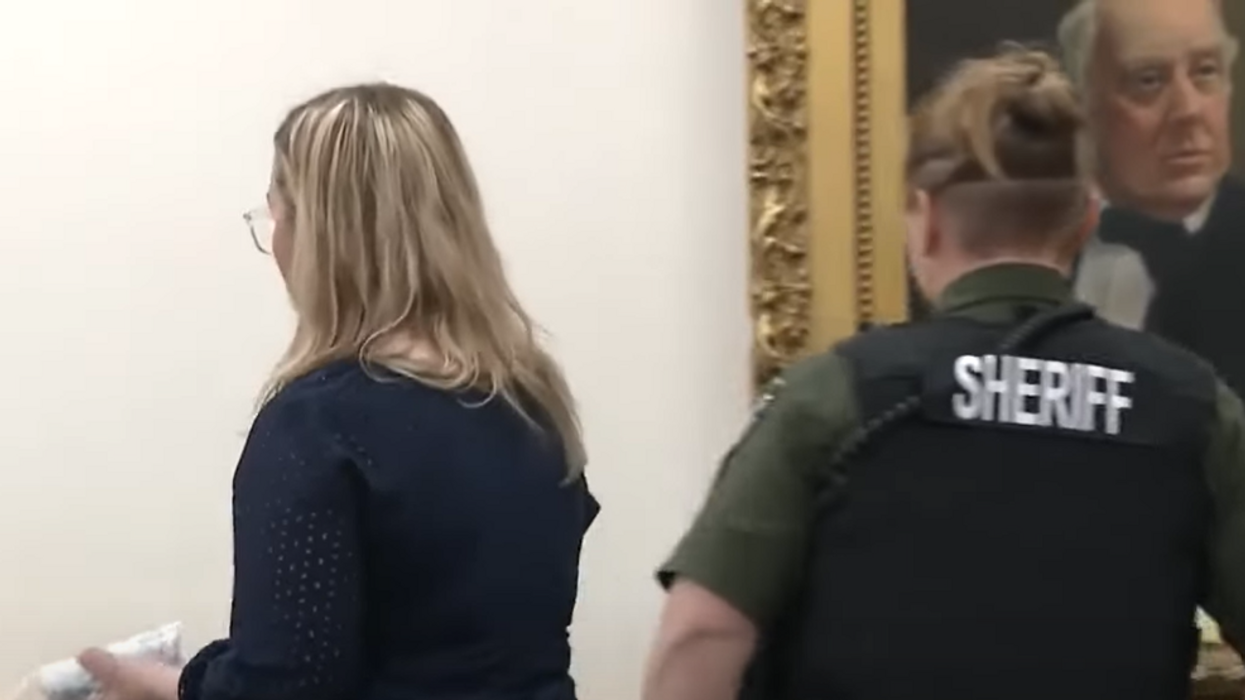
© 2024 Blaze Media LLC. All rights reserved.
This week, as Obama ratchets up his focus on releasing large numbers of felons from prison, Republicans are using the cover of the Benghazi hearing to push through a bill (S. 2123) that will codify Obama’s get out of jail free agenda. For more information on the specific provisions of the bill, click here.
Appallingly, some Republicans are trying to make the case that this is really part of a conservative agenda. Here is a list of talking points from their playbook to allure conservatives into supporting this bill and the broader effort in regards to criminal justice “reform.”
Talking Point #1: Our criminal justice system is broken
Reality:
The D.C. intelligentsia argues our criminal justice system is in dire need of reform. But ask anyone outside the beltway, and they’ll give you a different definition of “broken.” Many Americans would agree that current laws are toolenient on criminals and disregard the victim all too often. It was the tough reforms put into place during the Reagan years that produced the sharpest decline in violent crime on record. Those reforms, coupled with more aggressive policing led to the only positive social trend in public policy in recent memory. That trend is now being reversed precisely as incarceration rates decline and Obama and his allies ratchet up the war against law enforcement. While correlation doesn’t necessarily prove causation, the correlation is indeed striking, and in conjunction with the defanging of local police departments, the release of tens of thousands of federal prisoners can only result in exacerbating this negative trajectory.
The sentencing aspect of our criminal justice system is not broken: it’s the liberal judges and the legal profession that extorts existing loopholes to plead down a number of serious charges and endanger society. Add in the revolving door and recidivism of criminals, especially for juveniles who all too often receive a slap on the wrist, and you get a criminal justice system that is more lenient on criminals than it should be.
Talking Point # 2: There are millions of people incarcerated in American prisons and it costs too much
Reality:
While there are 2.2 million people incarcerated in American jails,prisons, and other institutions, only 205,491 are federal inmates. And only 165,000 are housed in actual prisons. The rest are in home confinement, short-term detention, long-term boarders, residential reentry centers, pre-trial/pre-sentence holding, etc. At least 25% of the federal prison population is comprised of illegal aliens and possibly more who are non-citizens. We should save money by releasing those criminals and deporting them. It is extremely misleading to conflate state numbers when promoting federal legislation dealing with the federal criminal code and the federal prison population. Moreover, as this is being written the Justice Department is already in the process of releasing 46,000 federal prisoners in one of the largest prison releases in American history, even before this legislation is adopted. This comes on the heels of several waves of releases since 2007, which has engendered a steady drop in the federal prison population.
That Republicans would be promoting legislation to release many of the remaining 150,000 of the most hardened federal criminals by using the talking point of mass incarceration is dishonest, illogical, and irresponsible.
Further, the entire notion of focusing on the prison population instead of protecting society and decreasing crime is inherently a far left principle. Sure, we have a lot of people in prison. We have even more criminals left on the streets. That is because we have systemic social problems in this country. As Heather MacDonald noted in her testimony before the committee, “the U.S. homicide rate is seven times higher than the combined rate of 21 Western nations plus Japan.” This needs to be dealt with at the systemic level instead of treating the symptom by letting everyone out of jail and endangering the public.
While incarceration costs have grown with the increase in prison population (which is already on a downward trajectory), how much money have we saved as a society from the massive decrease in violent crime corresponding with the same time period?
Talking Point # 3: This bill will only release low level, non-violent drug offenders
Reality:
This is one of the biggest myths of the soft on crime crowd. This bill will retroactively release thousands of hardened criminals, many of whom are illegal aliens. Those in the soft on crime caucus are dishonestly conflating state reform efforts dealing with simple marijuana possessions with federal offenses. They want to give the impression that there are thousands of people rotting in federal prison for simply smoking a joint. These politicians are well aware of the fact that those serving time in federal prison on drug offenses are either illegal aliens or big time traffickers of large quantities of dangerous drugs, including cocaine, meth, and heroin.
Consider the following:
- According to data from the U.S. Sentencing Commission, 95% of the 305 individuals serving time in federal prison for simple drug offenses are non-citizens and 95.7 % were sentenced in southwest border districts – virtually all of them in Arizona. Only 13 simple possession cases were tried in non-border districts in FY 2014. Even on a state level, drug possession accounts for only 3.6% of state prisoners in light of recent efforts to go soft on drug possession on multiple fronts. [1]
- Many of those convicted on drug charges have plead down to lesser charges but have been involved in violent crime. There is a reason increased incarceration has contributed to at least 25% of the two-decade long reduction in crime. A relatively small population of criminals commit most of the crimes and by locking them up for drug trafficking, these same individuals predisposed to commit violent crimes were taken off the streets.
- Under current law, there is a “safety valve” that has allowed 80,000 convicted drug offenders to escape the mandatory minimums. In FY 2014, 28.5% of all drug trafficking offenders escaped the mandatory minimum via the safety valve. This is why the length of time for drug sentencing is already shrinking across the board. Those remaining in federal prison today under the mandatory sentencing guidelines are undoubtedly hard-core criminals.
- According to a report released last year by the Bureau of Justice Statistics, 76.9% of drug offenders who were released from prison in 30 states from 2005-2010 were arrested again within 5 years. One can only imagine the affect of releasing felons from federal prison who are, on average, more violent than those in state prisons.
- In addition to retroactively releasing drug traffickers, the current bill pending before the House and Senate would reduce sentencing for felons convicted of firearms violations, even those with violent crime records, as noted in my write-up on S. 2123.
Talking Point # 4: We have a big government culture of over-criminalization that threatens liberty
Reality:
Absolutely. There are plenty of frivolous regulatory crimes on the books. And none of that is addressed in this legislation or any of the ongoing “bipartisan” negotiations. This is all about promoting the ACLU agenda for hardened criminals. As it relates to our culture of violent crime, witnessed by the recent spike in crime across the nation, we do not do enough to combat it. Ordered liberty is built upon government doing a few things well, one of which is law enforcement. Returning to pre-Reagan crime levels where people are restricted in their movements and activities due to the paralysis we are now seeing in places like Baltimore, represents the highest level of tyranny. Crime, lawlessness, and fiscal dependency policies undermine liberty in the inner cities, not sentencing and incarceration.
Talking Point # 5: Drug laws disproportionately hurt blacks
Reality:
The number of blacks serving in prison for drug trafficking is as disproportionately high to the white population as it is for other violent crimes. The reality is that predominantly black inner cities are riddled with violent crime and drugs and are merely one symptom of the problem. Once again, the goal here should be to address the root cause of the problem instead of treating the symptom.
Even if you release all drug offenders in state prisons, the percentage blacks comprise of the prison population would decrease from 37.5% to 37%. According to IBD’s analysis of the BJS statistics, “Blacks under 18 account for just 23% of the nation's drug offenses, but a shocking 52% of all violent crime — including 51% of murders, 69% of robberies, 34% of rapes and 43% of aggravated assaults.”
Besides, focusing on outcomes as opposed to equality of actions and opportunity should be a non-starter with conservatives and libertarians. The sad reality is that drugs and incarceration are symptoms of the violent crime problem we have in this country, and in the black community in particular. Black victims will be the most harmed by the dismantling of more aggressive policing, tougher sentencing, and more incarceration.
Talking Point # 6: Criminal justice reform promotes federalism.
Reality:
One of the more attractive libertarian arguments is that the federal government shouldn’t be involved in criminalizing drugs and should devolve it to the states. We can have that debate, but that is not the discussion of this bill or the broader effort. This bill keeps the feds involved in all aspects of drug laws; it merely lets those who have already been convicted out of jail without devolving responsibility to the states. The goal of this bill is not to prospectively clean up the federal criminal code but to focus singularly on reducing prison population retroactively at any cost.
Meanwhile, Congress is completely ignoring Obama’s violation of federalism by ignoring his racist investigations of local police departments. In fact, Congress has given Obama’s federal power grab tailwinds by creating a $50 million slush fund for the DOJ to help defang the police with a carrot and stick approach to hands-off policing.
Talking Point # 7: We don’t need mandatory sentencing to get criminals to cooperate
Reality:
During the hearing, a number of the Democrat and Republican proponents suggested that there are other ways to pressure criminals from cooperating with authorities other than mandatory minimums. But once again, this is all rooted in their unflinching trust in liberal judges. There is simply no way to deter criminals without mandating a floor for sentencing that cannot be manipulated by the legal profession.
Talking Point # 8: This bill doesn’t repeal mandatory minimums, it just gives more discretion to judges
Reality:
Sections 102 and 103 repeal the mandatory minimums by creating an entire new safety valve for judges to use. This argument is reminiscent of those proponents of amnesty who would extol the virtues of illegal immigration and amnesty, then proceed to passionately deny their bill was a form of amnesty. By definition, a mandatory minimum supersedes liberal discretion of a judge. By no longer making it mandatory for a number of categories, there is no enforcement mechanism. Sure, a judge could theoretically still issue the same sentence, but that is no longer a mandate. Republican supporters of this bill willfully ignore the lessons of the ‘60s and ‘70s with liberal judges.
What should scare people the most is that S. 2123 is just a down payment on dismantling law and order in this country – the first ship out to sea. And it is the least offensive version of what we might expect to come. Just like with immigration they introduce their agenda with many tough sounding caveats and talking points: amnesty will only apply to those as pure as the wind-driven snow, they will have to pay taxes, learn English, assimilate, etc. Likewise, in this case they are beginning with messaging pertaining to so-called nonviolent drug offenders. But once these policies are in the field and the general sense of liberalization reigns supreme in the courts, this will open the floodgates for the much broader ACLU agenda.
With the tide of crime rising throughout this country, isn’t it time to ask: where is the safety valve for law abiding Americans from this broader effort to coddle criminals?
Want to leave a tip?
We answer to you. Help keep our content free of advertisers and big tech censorship by leaving a tip today.
Want to join the conversation?
Already a subscriber?
Blaze Podcast Host
Daniel Horowitz is the host of “Conservative Review with Daniel Horowitz” and a senior editor for Blaze News.
RMConservative
more stories
Sign up for the Blaze newsletter
By signing up, you agree to our Privacy Policy and Terms of Use, and agree to receive content that may sometimes include advertisements. You may opt out at any time.
© 2024 Blaze Media LLC. All rights reserved.
Get the stories that matter most delivered directly to your inbox.
By signing up, you agree to our Privacy Policy and Terms of Use, and agree to receive content that may sometimes include advertisements. You may opt out at any time.



